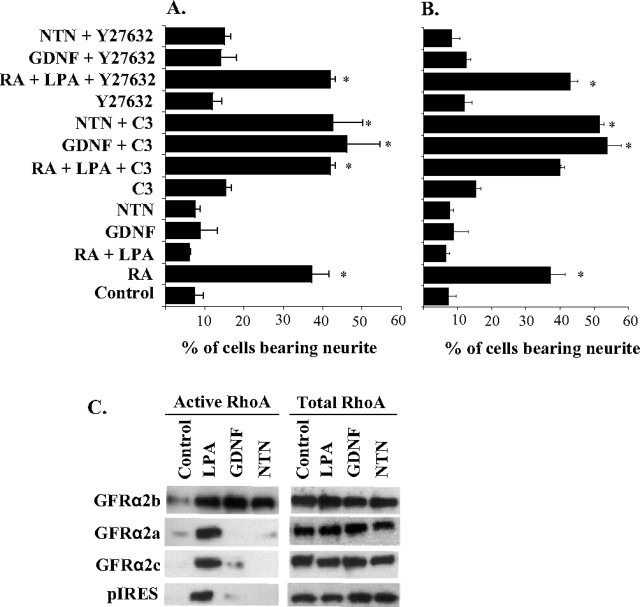Figure 9.
Effects of RhoA and ROCK inhibitors in ligand-induced neurite outgrowth of GFRα2 isoform coexpression models and the ligand-induced activation of RhoA in GFRα2 isoform transfectants. A, B, Effects of RhoA inhibitor exoenzyme C3 transferase (1 μg/ml) and ROCK inhibitor Y27632 (10 μm) on ligand-induced neurite outgrowth in coexpression models of GFRα2a and GFRα2b (A) or GFRα2c and GFRα2b (B). LPA was used as a positive control in this study. LPA (10 μm) antagonizes neurite outgrowth induced by 5 μm retinoic acid (RA); such neurite inhibition of LPA was attenuated by C3 (1 μg/ml) and Y27632 (10 μm). The means ± SD were calculated from results obtained in triplicates. The effects of RhoA and ROCK inhibitors were compared with the effects of the inhibitors alone. With the concentrations of inhibitors used, no significant cell deaths were observed. Significant differences in the percentage of cells bearing neurites were calculated between ligand stimulated and control, using the paired Student's t test (*p ≤ 0.01). C, Analyses of RhoA activation in Neuro2A cells transfected with GFRα2 isoforms or pIRES control. After a 10 min pretreatment of LPA (10 μm), GDNF, or NTN (50 ng/ml), GTP-bound RhoA was pulled down from cell lysates using GST–Rhotekin and immunoblotted for RhoA. LPA served as a positive control for RhoA activation. Blotting of total RhoA in cell lysates showed similar loading of cell lysates.

